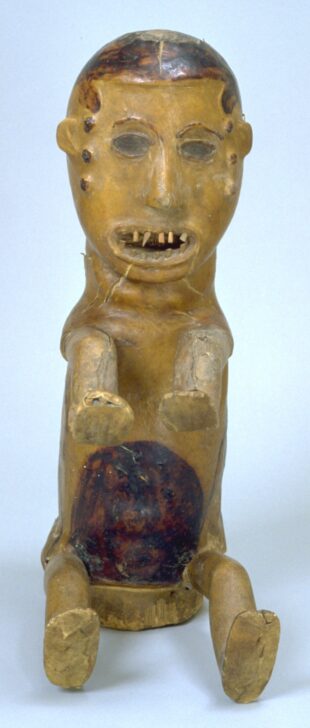Mask
Ejagham

Description
The Ekoi (sometimes referred to as the Ejagham) often cover wooden heads and figures with skin to make them look more lifelike. Fresh antelope skin is wrapped around the object and left to dry. Fatty particles on the uncleaned side of the skin allow it to adhere to the carving. These carvings are danced by special men's associations. They are attached to woven caps and worn on top of the head during dances. A dancer is covered by a gown extending from the top of the head to the ankles, leaving only the cap and figure visible.
Subject Matter:
The Cross River region on the border between Nigeria and Cameroon has a long history of trade and sharing artistic styles among the many peoples that call the area home. The practice of covering wooden masks with animal skin is thought to have originated with Ejagham peoples—formerly called Ekoi. Cap masks such as this one were worn with a raffia base on top of the head. Other forms of skin-covered masks were also made, including Janus-faced and hemlet masks, though not in recent years. While masks were usually named after the society they were used with, the society this mask belongs to is unknown. In general, they were used in festivals for entertainment and for important ceremonial occasions. They were also worn for funerals of important society members. The lighter color suggests this may be a female mask, which could possibly have been worn by men. Masks in the form of a figure with limbs are called utaturu by Widekum peoples, who live in the eastern Cross River region of Cameroon.
References Cited:
Nicklin, Keith. 1974. "Nigerian Skin-Covered Masks." African Arts, Vol. 7, No. 3, pp. 8-15, 67-68, 92.
Nicklin, Keith. 1979. "Skin-Covered Masks of Cameroon." African Arts, Vol. 12, No. 2, pp. 54-59, 91-92.
Physical Description:
A wooden crest mask covered with antelope skin in the form of a human figure with a columnar body and four outstretched limbs. The center of the figure's abdomen is dyed a dark brown, while the rest of the skin is light in color. On each side of the face are three dark circles in a vertical line.
Usage Rights:
If you are interested in using an image for a publication, please visit https://umma.umich.edu/request-image/ for more information and to fill out the online Image Rights and Reproductions Request Form.